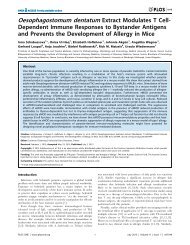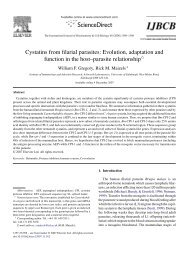Experimental Parasitology - Rick Maizels' Group - University of ...
Experimental Parasitology - Rick Maizels' Group - University of ...
Experimental Parasitology - Rick Maizels' Group - University of ...
Create successful ePaper yourself
Turn your PDF publications into a flip-book with our unique Google optimized e-Paper software.
deficient mice (µMT or JHD) fail to express protective immunity when challenged following the<br />
drug-abbreviated infection regimen that successfully primes wild-type mice (Wojciechowski, et<br />
al., 2009, Liu, et al., 2010). However, in JHD mice, both the adaptive Th2 and Foxp3 + Tregs<br />
responses, as well as the innate Type 2 development <strong>of</strong> alternatively activated macrophages in<br />
granulomas around encysted H. polygyrus larvae, are comparable to wild-type mice (Liu, et al.,<br />
2010). Hence, the extent to which B cells are a determining factor in the response phenotype<br />
depends on the model, with a more critical role only operative in the particular context <strong>of</strong> the<br />
chimeric mouse constructs.<br />
Antibody responses in infection<br />
In H. polygyrus infections, several lines <strong>of</strong> evidence argue for a key role for antibodies in<br />
immunity to H. polygyrus, even though expulsion <strong>of</strong> other gut helminths such as N. brasiliensis is<br />
clearly antibody-independent (Liu, et al., 2010). Antibody responses correlate with reduced<br />
worm numbers across different mouse strains (Zhong and Dobson, 1996) as well as within<br />
mouse strains (Ben-Smith, et al., 1999). Importantly, a causal link has been established by<br />
passive transfer experiments. Hyperimmune serum (from multiple rounds <strong>of</strong> infection) (Williams<br />
and Behnke, 1983), and the IgG1 fraction in particular (Pritchard, et al., 1983), could transfer a<br />
degree <strong>of</strong> immunity, with reduced worm survival and stunting <strong>of</strong> parasites that remained.<br />
Importantly, serum transfer was found to be effective only if administered during the encysted<br />
stage <strong>of</strong> infection (Behnke and Parish, 1979), and anti-larval immune effects such as growth<br />
retardation that are absent in JHD mice were restored by transfer <strong>of</strong> immune serum (Liu, et al.,<br />
2010). While another study was unable to restore immunity in MT mice, this employed a more<br />
limited regimen <strong>of</strong> immune serum transfer, perhaps suggesting that antibody-mediated anti-<br />
fecundity requires relatively high titres in vivo (Wojciechowski, et al., 2009).<br />
IgG1, despite its reported high potential to trigger inhibitory FcR signalling (Pleass and Behnke,<br />
2009), remains the most likely protetive isotype, as experiments with IgE- (McCoy, et al., 2008)<br />
and high-affinity IgE receptor-deficient (Finkelman, et al., 1997) mice argue against a role for IgE<br />
in immunity. In addition, µS mice which lack the ability to secrete IgM are fully protected from<br />
challenge infection (Wojciechowski, et al., 2009), as are IgA -/- mice (McCoy, et al., 2008).<br />
Maternal IgG was also demonstrated to confer protection against H. polygyrus in newborn mice<br />
(Harris, et al., 2006).<br />
An important issue that remains to be resolved is the role <strong>of</strong> antibodies in anti-fecundity<br />
Maizels et al Hydra Special Issue Page 13





